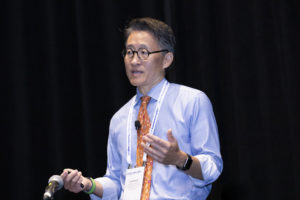Disney and Pixar are not only popular in Orlando, each was a part of the theme for Sunday’s “SOAP Gertie Marx Honorary Lecture – Obstetric Anesthesia: Are We There Yet?” Lawrence C. Tsen, M.D., Director of Anesthesia at Brigham and Women’s Hospital and Associate Professor of Anesthesia at Harvard Medical School, wove the Disney and Pixar themes into his session, in part, because of the underlying focus at Pixar Studios.

Lawrence C. Tsen, M.D.
Pixar’s messages, said Dr. Tsen, are “about family, about life, about how we should conduct ourselves.” He focused in particular on the movie “Coco,” which follows a young boy on a journey through his family’s past to learn about their complicated relationship with music.
As the movie character’s path was informed by those of his predecessors, so was Dr. Tsen’s in the pursuit of anesthesiology, as he benefitted from those who came before him.
Like Dr. Marx did, Dr. Tsen focuses on what happens to a fetus when the mother receives general anesthesia. At Brigham and Women’s Hospital, he’s been trying to think of ways to reduce the instances of general anesthesia caesarean deliveries, as they are harnessed to morbidity and mortality and move the bond between the parent and the fetus.
“Mortality has decreased, but we still have associated morbidities,” Dr. Tsen said.
In this pursuit, Dr. Tsen outlined tips for anesthesiologists to implement in their own facilities. He recommended developing a core team with quality assurance and quality improvement and getting on the same page as much as possible in terms of mental models and expectations, as well as methods and management styles. Facilities should institute high-risk consult systems to create multispecialty plans, establish expectations by patients and providers, and generate referrals and revenues.
It’s also crucial, said Dr. Tsen, that facilities mandate the ability to see all parturients and deputize early warning systems. Inserting early epidural catheters and confirming that those are functioning can be critical in avoiding general anesthesia caesarian deliveries, as can implementing the fastest anesthesia combo when necessary – affirming your team’s commitment to a neuraxial technique and developing interdisciplinary forums to ensure everyone in the facility follows the same protocol with each patient.
Another passion Dr. Tsen shares with Dr. Marx is the mission of improving labor analgesia. Rather than an epidural, Dr. Tsen suggested administering a combined spinal epidural (CSE). CSEs, he said, can lead to lower instrumental delivery and shorter labor and delivery times. CSEs also have the advantage on epidurals when it comes to location confirmation, onset, sacral spread and bilateral spread, although he noted that CSEs do have disadvantages in terms of fetal bradycardia, uterine hypertonus, adverse events and the workload of the staff involved.
On honoring Dr. Marx’s legacy, Dr. Tsen was humbled to follow in her footsteps, comparing a legacy to “striking that match and opening up someone’s eyes.”
“When we think about legacy, we need to foster our ideas on sharing treasure and talent,” Dr. Tsen said. “I’m thankful that my own path has been informed by others such as Dr. Marx.”
Return to Archive Index